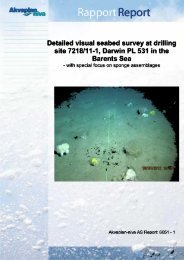A study of the priority substances of the Water Framework Directive ...
A study of the priority substances of the Water Framework Directive ...
A study of the priority substances of the Water Framework Directive ...
You also want an ePaper? Increase the reach of your titles
YUMPU automatically turns print PDFs into web optimized ePapers that Google loves.
..:::::::::: alachlor<br />
..:::12<br />
1 Alachlor<br />
� Alachlor is an herbicide (pesticide), used<br />
against grass weeds and broadleaves.<br />
� No information on use in Norway is available.<br />
� There are no available data on environmental<br />
distribution in Norway.<br />
� The potential for transboundary pollution is<br />
limited due to short life span in air.<br />
� No fur<strong>the</strong>r screening is considered necessary.<br />
Production and use<br />
Alachlor has not been approved as herbicide in<br />
Norway, and <strong>the</strong>re is no registered import since<br />
1974. Alachlor has been banned in Sweden<br />
since 1978, widely used in <strong>the</strong> US.<br />
Emissions, discharges,<br />
distribution and hot-spots<br />
There is no available data on environmental distribution<br />
in Norway.<br />
Monitoring<br />
There is no available data on screening or monitoring<br />
in Norway.<br />
Need for fur<strong>the</strong>r screening and monitoring<br />
There is no recorded use <strong>of</strong> alachlor in Norway.<br />
In Sweden no concentrations <strong>of</strong> alachlor above<br />
detection limits were found in fish, sediments or<br />
ground water (IVL Rapport, 2004). There is no<br />
need for fur<strong>the</strong>r screening or monitoring.<br />
Analysis<br />
The analysis <strong>of</strong> alachlor is <strong>of</strong>ten part <strong>of</strong> multi<br />
pesticide packages <strong>of</strong>fered by several laboratories.<br />
Methods<br />
The methods are based on direct extraction with<br />
an organic solvent (sediment and biota) or solid<br />
phase extraction (SPE), eventually clean-up with<br />
SPE and separation and quantification with GCbased<br />
methods: GC/MS or GC/ECD, however,<br />
also LC/MS methods can be used.<br />
Synergy with o<strong>the</strong>r analyses<br />
Sample extraction and clean-up can be co-ordinated<br />
with <strong>the</strong> analysis <strong>of</strong> o<strong>the</strong>r pesticides which<br />
can be analysed by GC/MS especially o<strong>the</strong>r<br />
amide-type herbicides as for example metolachlor.<br />
A <strong>study</strong> <strong>of</strong> <strong>the</strong> <strong>priority</strong> <strong>substances</strong> <strong>of</strong> <strong>the</strong> <strong>Water</strong> <strong>Framework</strong> <strong>Directive</strong><br />
TA-2140/2005<br />
FACTS<br />
Cas no.: 15972-60-8<br />
Synonyms: Acetamide, 2-chloro-N-(2,6-diethylphenyl)n-(methoxymetyl)-<br />
Alanex, Bronco, Cannon, Crop<br />
Star, Lariat, Lasso, and Partner.<br />
Properties: Alachlor is a colourless to yellow crystal<br />
compound<br />
Toxic effects: Slightly toxic. Oral LD50 in rat is<br />
between 930 mg/kg and 1350 mg/kg. Irritates skin.<br />
Alachlor is moderately toxic to fish The LC50 (96-hour)<br />
2.4 mg/l in rainbow trout (Oncorhynchus mykiss)<br />
(EXTOXNET). It is on <strong>the</strong> EU list <strong>of</strong> <strong>substances</strong> with documented<br />
endocrine-disrupting effects.<br />
Log Kow: 3,7<br />
Persistence: Low persistence in soil (8 days) and<br />
water (EXTOXNET), higher in anaerobic water (HSDB).<br />
DT50 water = 200 - 500 d (river water without sediment),<br />
23 -206 d (river water after addition <strong>of</strong> soil or<br />
sediment)<br />
DT 50 whole system = 18 -37 days (CIRCA).<br />
<strong>Water</strong> solubility: 18,07 mg/l (25°C)<br />
Molecular formula: C 14 H 20 Cl-NO 2<br />
Metabolites: diethylaniline (urine), 2-chloro-2',6'diethylacetanilide<br />
and 1-chloro-acetyl-2,3-dihydro-7ethylindole<br />
(soil) (HSDB)<br />
Use: Herbicide, annual grass weeds, some<br />
broadleaves for protection <strong>of</strong> corn, soybeans, and<br />
peanuts, potatoes, sorghum etc. (HSDB).<br />
References<br />
� HSDB, Alachlor<br />
� CIRCA Royal Haskoning fact sheets on production,<br />
use and release <strong>of</strong> <strong>priority</strong> <strong>substances</strong> in<br />
<strong>the</strong> WFD, Alachlor, Final version 31 January<br />
2003<br />
� IVL Rapport (Naturvårdsverket): Occurrence<br />
<strong>of</strong> <strong>the</strong> WFD <strong>priority</strong> <strong>substances</strong> in Sweden - a<br />
summary <strong>of</strong> recent environmental monitoring.<br />
2004-03-29.<br />
� Environmental Review no. 15, 2004: List <strong>of</strong><br />
Undesirable Substances 2004, Appendix B -<br />
Substances on <strong>the</strong> EU list <strong>of</strong> <strong>substances</strong> with<br />
documented endocrine-disrupting effects<br />
� EXTOXNET Extension Toxicology Network<br />
Pesticide Information Pr<strong>of</strong>iles<br />
Alachlor Oregon State University Revised June<br />
1996

















